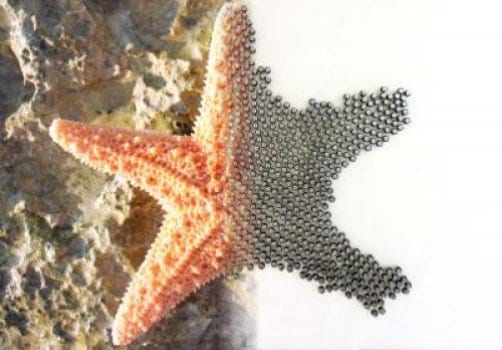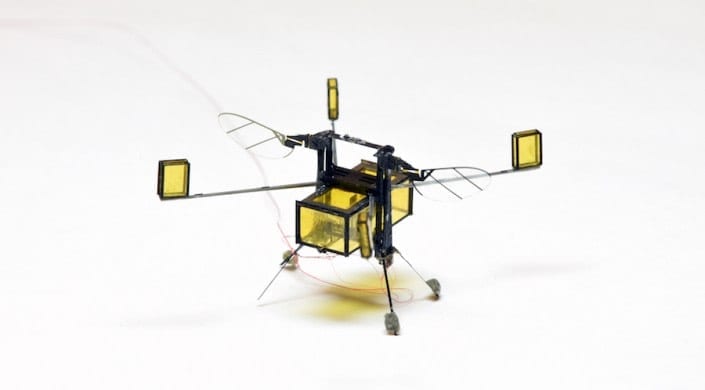
Credit: Photo courtesy of Mike Rubenstein and Science/AAAS
“Form a sea star shape,” directs a computer scientist, sending the command to 1,024 little bots simultaneously via an infrared light. The robots begin to blink at one another and then gradually arrange themselves into a five-pointed star. “Now form the letter K.”
The ‘K’ stands for Kilobots, the name given to these extremely simple robots, each just a few centimeters across, standing on three pin-like legs. Instead of one highly-complex robot, a “kilo” of robots collaborate, providing a simple platform for the enactment of complex behaviors.
Just as trillions of individual cells can assemble into an intelligent organism, or a thousand starlings can form a great flowing murmuration across the sky, the Kilobots demonstrate how complexity can arise from very simple behaviors performed en masse (see video). To computer scientists, they also represent a significant milestone in the development of collective artificial intelligence (AI).
This self-organizing swarm was created in the lab of Radhika Nagpal, Fred Kavli Professor of Computer Science at the Harvard School of Engineering and Applied Sciences (SEAS) and a Core Faculty Member at the Wyss Institute for Biologically Inspired Engineering at Harvard University. The advance is described in the August 15 issue of Science.
“The beauty of biological systems is that they are elegantly simple—and yet, in large numbers, accomplish the seemingly impossible,” says Nagpal. “At some level you no longer even see the individuals; you just see the collective as an entity to itself.”
“Biological collectives involve enormous numbers of cooperating entities—whether you think of cells or insects or animals—that together accomplish a single task that is a magnitude beyond the scale of any individual,” says lead author Michael Rubenstein, a research associate at Harvard SEAS and the Wyss Institute.
He cites, for example, the behavior of a colony of army ants. By linking together, they can form rafts and bridges to cross difficult terrain. Social amoebas do something similar at a microscopic scale: when food is scarce, they join together to create a fruiting body capable of escaping the local environment. In cuttlefish, color changes at the level of individual cells can help the entire organism blend into its surroundings. (And as Nagpal points out—with a smile—a school of fish in the movie Finding Nemo also collaborate when they form the shape of an arrow to point Nemo toward the jet stream.)
“We are especially inspired by systems where individuals can self-assemble together to solve problems,” says Nagpal. Her research group made news in February 2014 with a group of termite-inspired robots that can collaboratively perform construction tasks using simple forms of coordination.
The Latest on: Self-organizing robots
[google_news title=”” keyword=”Self-organizing robots” num_posts=”10″ blurb_length=”0″ show_thumb=”left”]
via Google News
The Latest on: Self-organizing robots
- My Favorite Amazon Deal of the Day: The Roborock Q7 Max+on May 8, 2024 at 5:01 am
The Roborock Q7 Max+ is a powerful robot vacuum and mop combo with a self-emptying dock station. Currently, it is more than $400 off after a 47% discount, the lowest price it has been yet.
- Could a robot care for grandma?on May 7, 2024 at 1:21 am
As part of the photographer’s project, elderly people were asked to imagine how they would interact with a robot. A resident at Maison Ferrari, a retirement home in Clamart, France, volunteered ...
- Random robots are more reliableon May 2, 2024 at 1:19 pm
New algorithm encourages robots to move more randomly to collect more diverse data for learning. In tests, robots started with no knowledge and then learned and correctly performed tasks within a ...
- The Best Robot Mops for 2024on April 30, 2024 at 5:00 pm
Retire your old mop and bucket. The top robot mops we've tested keep your floors spick-and-span with little effort on your part. I'm PCMag's managing editor for consumer electronics, overseeing an ...
- The Best Robot Vacuums for 2024on April 30, 2024 at 5:00 pm
The Ecovacs Deebot X2 Omni is the most self-sufficient robot vacuum that we’ve ever tested. The X2’s robust array of sensors help it efficiently map and navigate your home.
- Self Balancing Roboton April 29, 2024 at 5:00 pm
Stabilizing an inverted pendulum is a classic problem in control theory, and if you’ve ever taken a control systems class you might remember seeing pages full of differential equations and bode ...
- Enter Robots, Are We Ready?on April 24, 2024 at 5:00 pm
The term “robot” suggests a human-like machine—a ... will give patients increasing control of these bionic parts. Self-contained power sources, combined with artificial intelligence (AI ...
- My Favorite Amazon Deal of the Day: The Roborock S8 Pro Ultraon April 23, 2024 at 5:00 pm
and self-cleaning. It has a 200 ml water tank capacity for mopping and a runtime of 180 minutes. While this is a premium robot vacuum, it is not perfect. PCMag's reviewer said it lightly scratched ...
- The 6 best self-emptying robot vacuums for no-effort cleaning in 2024on April 19, 2024 at 2:00 am
The best self-emptying robot vacuums have one huge perk past the obvious act of vacuuming the floor for you. (Hint: It's in the name.) When you outsource vacuuming to a robot, your floors get ...
- How Found Energy went from ‘self-cannibalizing robots’ to cleaning up heavy industryon April 17, 2024 at 6:01 am
“They gave me a bunch of money to start a program that I lovingly called the ‘self-cannibalizing robot lab,’” Godart told TechCrunch. “We looked at giving robots the ability to consume ...
via Bing News










